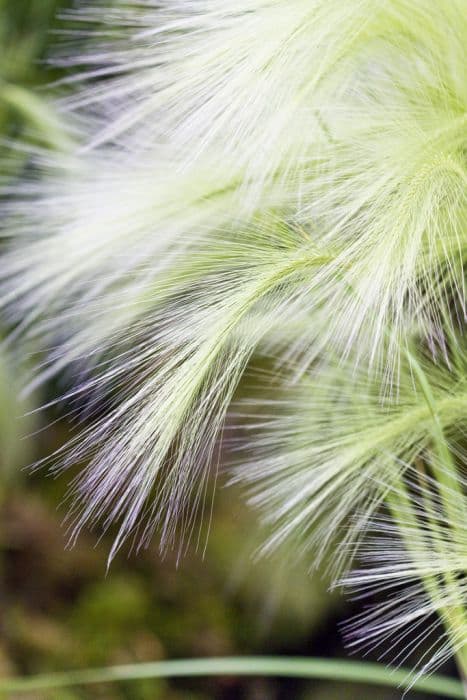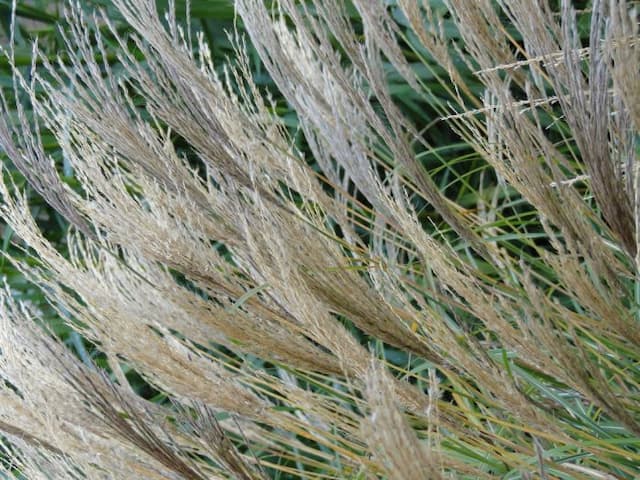Foxtail Barley Hordeum jubatum

ABOUT
The plant known as foxtail barley is characterized by its distinctive and ornamental seed heads, which resemble the bushy tail of a fox. These seed heads have long, silky awns that can be a purplish-green color when young, maturing to a golden or beige hue. The awns give the seed head a soft, feathery appearance that sways gracefully in the wind. The leaves of the foxtail barley are typically narrow and arching, with a blue-green or gray-green color that creates a nice contrast with the fluffy seed heads. The plant has a clumping growth habit, forming tufts that can be quite dense. While in flower, the foxtail barley produces a cloud of colour that provides a striking visual interest in the landscape, attracting attention with its fluffy, waving seed heads that shimmer in the sunlight.
About this plant
 Names
NamesFamily
Poaceae.
Synonyms
Foxtail Barley, Squirreltail Barley, Intermediate Barley, Bobtail Barley, Squirrel Tail Grass, Skunktail, Wild Barley.
Common names
Critesion jubatum, Elymus jubatus, Hordeum caespitosum, Hordeum jubatum subsp. intermedium, Hordeum jubatum subsp. jubatum, Hordeum jubatum var. caespitosum, Hordeum jubatum var. intermedium, Hordeum jubatum var. jubatum, Hordeum jubatum var. longiaristatum, Hordeum longiaristatum.
 Toxicity
ToxicityTo humans
The plant known as foxtail barley is not typically considered toxic to humans in the sense of being poisonous. However, the barbed seeds of the plant can cause physical irritation if they come into contact with skin, or if they are accidentally ingested they can cause mechanical injury to the gastrointestinal tract, potentially leading to discomfort or more severe complications if a large amount is swallowed or if they get stuck in the digestive system.
To pets
Foxtail barley is known to be hazardous to pets, especially dogs and other animals with fur. The barbed seeds can get embedded in the skin or fur of animals, leading to irritation or infection. If ingested, these seeds can cause serious damage to the digestive tract, leading to symptoms such as coughing, sneezing, nasal discharge, difficulty eating, or swollen neck glands. In severe cases, the sharp seeds can perforate the lining of the digestive system, requiring surgical intervention. It is not recognized as toxic in a chemical sense, but its physical structure poses a significant risk.
 Characteristics
CharacteristicsLife cycle
Perennials
Foliage type
Deciduous
Color of leaves
Green
Flower color
Varies
Height
2-3 feet (60-91 cm)
Spread
1-2 feet (30-60 cm)
Plant type
Grass
Hardiness zones
4
Native area
North America
Benefits
 General Benefits
General Benefits- Erosion Control: Hordeum jubatum, commonly known as Foxtail Barley, helps stabilize soil and prevent erosion with its root system.
- Wildlife Habitat: Foxtail Barley provides cover and nesting material for birds and small mammals.
- Aesthetic Appeal: With its attractive feathery plumes, Foxtail Barley is used in landscaping for visual interest.
- Drought Tolerance: The plant is adapted to survive in dry conditions, making it suitable for xeriscaping.
- Adaptability: Foxtail Barley can grow in a wide range of soil types, including saline and alkaline soils.
- Pasture Improvement: When managed carefully, it can contribute to the diversity of pastures, although it can become problematic if allowed to dominate.
- Soil Health: Its roots can help improve soil structure and organic matter content.
- Low Maintenance: Once established, Foxtail Barley requires minimal care, making it suitable for naturalized areas.
 Medical Properties
Medical PropertiesThis plant is not used for medical purposes.
 Air-purifying Qualities
Air-purifying QualitiesThis plant is not specifically known for air purifying qualities.
 Other Uses
Other Uses- Hordeum jubatum, commonly known as foxtail barley, can be used for ornamental purposes in landscaping due to its attractive and feathery seed heads that add visual interest to gardens.
- Foxtail barley's ability to grow in saline soils makes it an excellent plant for soil stabilization and rehabilitation of degraded lands affected by salinity.
- The plant is sometimes used in dried floral arrangements, where its distinctive fluffy seed heads can add texture and a rustic charm to bouquets.
- Foxtail barley can serve as fodder for livestock, although its sharp awns must be removed before consumption to avoid injury to the animals.
- The grains of foxtail barley, although not a primary food source, can be ground into flour and used as a supplementary grain in baking.
- The plant's extensive root system has been utilized in various regions for erosion control, helping to keep soil in place on slopes and banks.
- Some crafters harvest the stalks of the foxtail barley to include in homemade paper, providing a natural decorative element.
- Foxtail barley provides habitat for wildlife, including small mammals and birds, which may use the dense growth for shelter or nesting material.
- In regions where it is native, foxtail barley has been traditionally used to weave baskets and other objects by local indigenous communities.
- The seeds of foxtail barley can be used as microgreens for culinary purposes, adding a unique flavor and texture to dishes.
Interesting Facts
 Feng Shui
Feng ShuiThe Foxtail Barley is not used in Feng Shui practice.
 Zodiac Sign Compitability
Zodiac Sign CompitabilityThe Foxtail Barley is not used in astrology practice.
 Plant Symbolism
Plant Symbolism- Fertility - Hordeum jubatum, commonly known as Foxtail Barley, has a fluffy, feather-like appearance reminiscent of abundance and growth, often symbolizing fertility and the capacity for life to proliferate.
- Resilience - Foxtail Barley is known for its ability to grow in a variety of conditions, including poor soil, which makes it a symbol of resilience and adaptation in the face of adversity.
- Provision - As a member of the grain family, Foxtail Barley can represent sustenance and the provision of basic needs, aligning with the symbolic meaning of grains as staples of human nourishment.
- Humility - Despite its ornamental appeal, Foxtail Barley is a relatively simple and common plant, often symbolizing humility and unpretentiousness.
 Water
WaterFoxtail barley prefers consistent moisture, especially during its growing season, which is primarily in the spring and early summer. It's important to water deeply, providing about one inch of water per week, either through rainfall or manual watering. Make sure the soil is allowed to dry out slightly between watering sessions to prevent root rot. For young plants, more frequent watering may be needed to maintain the consistently moist soil conditions required for optimal growth. Decrease the amount of water as the plant matures and during the dormant season in the fall and winter.
 Light
LightAs a native grass, foxtail barley thrives in full sunlight conditions, meaning it requires at least six hours of direct sunlight per day. It can also tolerate partial shade but will perform best in a spot that receives ample sunlight. Ensure the selected location isn't shaded by taller plants or structures during the day, as this could limit the plant's growth and development.
 Temperature
TemperatureFoxtail barley is a hardy plant that can withstand a range of temperatures. It grows best in temperatures between 50 to 75 degrees Fahrenheit but can survive in temperatures as low as 20 degrees and as high as 90 degrees Fahrenheit. The ideal temperature conditions for foxtail barley would fall within the moderate range, avoiding extremes of heat or cold.
 Pruning
PruningPruning foxtail barley isn't necessary for plant health but can be done to maintain a desired shape or size. If you choose to prune, do so after the plant has finished blooming and has begun to go dormant, typically in late summer or early fall. Simply cut back the foliage to clear away old growth and encourage fresh sprouting in the next growing season. Pruning is usually done once a year and should be performed with clean, sharp shears.
 Cleaning
CleaningNot needed
 Soil
SoilFoxtail Barley thrives in well-draining soil with a pH between 6.0 and 7.5. A mix of sandy loam and peat can be ideal, ensuring proper aeration and drainage. An application of balanced fertilizer occasionally will support its growth.
 Repotting
RepottingFoxtail Barley does not typically require frequent repotting. It should be repotted if it outgrows its container or if the soil is exhausted, usually every 2-3 years.
 Humidity & Misting
Humidity & MistingFoxtail Barley prefers moderate humidity conditions and can tolerate some dry air, but does not require high humidity levels to thrive.
 Suitable locations
Suitable locationsIndoor
Place Foxtail Barley in bright light and use a well-draining soil mix.
Outdoor
Ensure full sun to partial shade and well-draining soil for Foxtail Barley.
Hardiness zone
4-9 USDA
 Life cycle
Life cycleHordeum jubatum, commonly known as foxtail barley, begins its life as a seed, lying dormant until conditions are suitable for germination. Upon germination, it develops a root system and a shoot that grows upwards, entering the vegetative stage where leaves and stems expand and it grows rapidly in size. During the reproductive stage, foxtail barley produces a distinct feathery inflorescence, which then blooms, allowing for pollination and seed formation. Once pollination has occurred, the plant focuses energy on developing seeds in the spikelets, which when mature, are dispersed by wind, animals, or mechanical means. In the next phase of its life cycle, the plant senesces and dies, leaving the seeds in the soil to continue the next generation. As an annual or short-lived perennial in various climates, foxtail barley may complete this life cycle within one year or over a couple of years in colder regions.
 Propogation
PropogationPropogation time
Spring
Foxtail barley, known scientifically as Hordeum jubatum, is typically propagated through seeds. The most popular method involves sowing the seeds directly into the prepared soil. This is done in the spring after the danger of frost has passed. The area should be raked to a fine tilth and the seeds scattered at a rate of approximately 15-20 seeds per square foot (roughly 150-200 seeds per square meter). Then, a light raking can help to ensure that the seeds are lightly covered with soil. Watering should be done gently to keep the soil moist without disturbing the seeds until germination, which usually takes place within 2 to 3 weeks.









